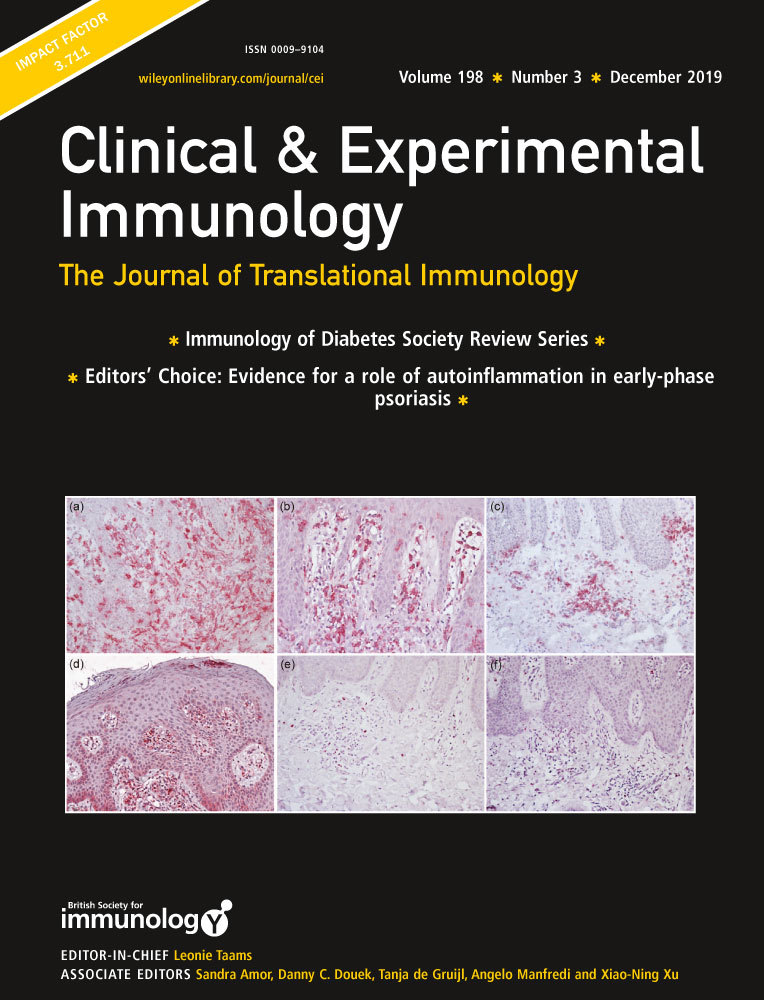Historical and new insights into pathogenesis of type 1 diabetes
OTHER ARTICLES PUBLISHED IN THIS REVIEW SERIES
Birth and coming of age of islet autoantibodies. Clinical and Experimental Immunology 2019, 198: 294–305.
HIPs and HIP-reactive T cells. Clinical and Experimental Immunology 2019, 198: 306–313.
Immune cell trafficking to the islets during type 1 diabetes. Clinical and Experimental Immunology 2019, 198: 314–325.
Islet-immune interactions in type 1 diabetes: the nexus of beta cell destruction. Clinical and Experimental Immunology 2019, 198: 326–340.
Summary
In recent years, there have been exciting new insights into pathogenesis of type 1 diabetes in a number of areas of immunology. In this edition, a collection of four review articles are presented, which encompass new findings presented at the Immunology of Diabetes Society meeting in London 2018. The articles are focused particularly in 4 related areas of investigation, which include autoantibodies in type 1 diabetes, new autoantigenic targets for CD4 T cells, trafficking of immune cells to the pancreas and islet-immune interactions in the pancreas.
Interaction within the immune system plays a central role in the development of type 1 diabetes, a complex autoimmune disease in which the insulin-producing beta cells of the pancreas are damaged and destroyed. Many discoveries have been made over the last few years, which have advanced our understanding of the pathogenesis of human type 1 diabetes, aided by discoveries in animal models that include the much-studied non-obese diabetic (NOD) mouse. Type 1 diabetes is a disease in which genetically susceptible individuals develop diabetes at a variable age, which can range from the very young (6 months), to over 70 years. In the United Kingdom, it is estimated that there are about 400,000 people who have developed type 1 diabetes.
One of the earliest indicators that type 1 diabetes is an autoimmune disease was the measurement of autoantibodies found in the serum, in the 1970s with the measurement of islet-cell antibodies (ICA). Subsequently, more specific targets have been identified that include proinsulin, glutamic acid decarboxylase (GAD), islet antigen-2 (IA-2), Zinc Transporter 8 (ZnT8). In the 45-year history of islet autoantibody research, Bonifacio and Achenbach chronicle the discovery since the first publication in 1974, through to the current time, in which autoantibodies can be used to screen for individuals with presymptomatic early stage type 1 diabetes 1. This is of considerable importance as we enter an era in which there are active clinical trials to find ways to stop the autoimmune process, and potentially prevent disease. The identification of specific target antigens recognised by autoantibodies, led to the investigation and identification of the antigenic targets for autoreactive T cells. For the T cell target identification, the NOD mouse model has been particularly useful, with identification of autoantigenic targets in the mice, in which pathogenic T cells can be actually shown to damage islets recognising the targets. Whilst the antigenic targets for pathogenic CD8 T cells have been known for some years, the antigenic targets for CD4 T cells have been more elusive. The autoantigen recognized by one of the most studied highly pathogenic CD4 T cell clones BDC2.5, derived from the NOD mouse and which has given rise to many important insights into the role of CD4 T cells in type 1 diabetes, has only recently been identified. Delong and colleagues showed that the antigen was intriguingly, a hybrid peptide target that combines a proinsulin peptide with a peptide from chromogranin A, and they have described this in their review article in this issue 2. Wiles and Delong discuss the discovery of hybrid peptides for CD4 T cell clones, including the observation that they are also antigenic for human CD4 T cells, as well as the mechanism by which these may be formed. It is highly possible that this mechanism may explain why identification of the antigenic targets has been hitherto somewhat challenging and opens up a new way of thinking about the development of autoantigenic targets for autoimmunity in general.
Once autoreactive T cells are activated, they traffic to the pancreas, and enter to infiltrate the pancreatic islets of Langerhans, and damage the insulin-producing beta cells. This is a key process in the pathogenic process and Sandor and colleagues review elegant studies in the NOD mouse, which demonstrate components of the pathogenic cell trafficking into the islets. They discuss the role of mononuclear phagocytic cells, that include dendritic cells, macrophages and monocytes, as well as the surface molecule and chemokine components that are required for this movement of the cells into the islets 3. Understanding these processes may point to some new possibilities for therapeutic targeting as this may lead to less immunosuppression than non-antigen-specific targeting of individual cell types involved in the pathogenesis of diabetes.
In the final article in this series, Peters and colleagues have comprehensively reviewed immune cell – islet interactions in type 1 diabetes, which lead to the damage and destruction of the insulin – producing beta cells. They discuss findings from both mouse models and human type 1 diabetes, with a major focus on what is known about pathological processes in humans 4. In recent years, the availability of human pancreas samples from individuals with type 1 diabetes, together with advanced technologies, have facilitated considerable advance in our knowledge and understanding of the pathology of human type 1 diabetes. While there is clearly much to still be learned, we appreciate the information that has been derived from the sign-posting from the mouse studies, that have opened the way to study and investigate similar pathologic processes in humans. This, in turn, may lead to an increase in the possible therapeutics for this complex multifactorial immune based disease.
Together these reviews give insight into both historical perspectives as well as recent advances in important research into the pathogenesis of type 1 diabetes, and summarise highlights of a field of research in which much progress has been made.




